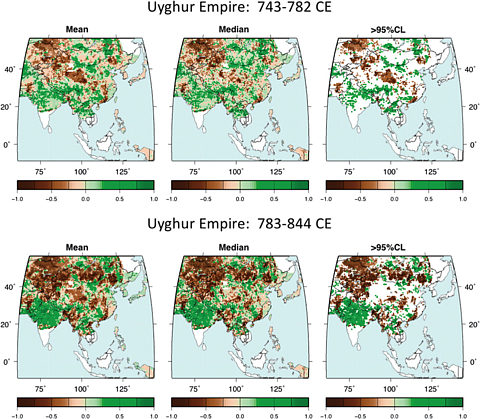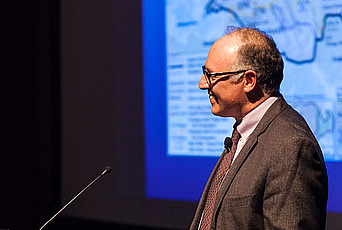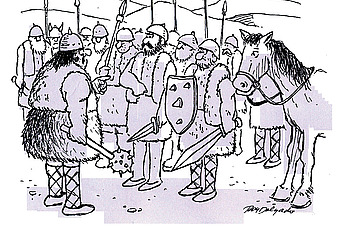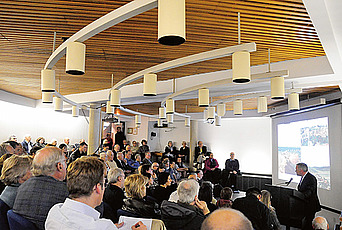The Scientist as Antiquarian: History, Climate, and the New Past

Half a century ago a French historian of rural Languedoc published a history of climate and people: climate changes, is subject to fluctuations, and (since history is about change) climate is the object of history.2 Le Roy Ladurie’s implied (if imperfect) syllogism captures perfectly the essence of the relationship between climate and history, natural and human systems, laboratory data and written sources.
To be clear, climate is neither nature nor environment. Climate is not even the weather. Climate is connected with and produced by the Earth’s system, affected by the solar system, and its variations transform ecologies: dry to wet, cold to warm, and vice versa, in different degrees of intensity and duration. Until recently, climate variability was caused only by a series of interacting natural forces that determined the length of seasons, the amount of rainfall, and the temperature of the atmosphere at different latitudes. Human beings had to face the consequences of this variability, enjoying balmy days while preparing for poor ones, feasts and famines punctuating the life cycles of humanity. How could this constant interaction between humans and nature not be part of history?
And yet, until the publication of Ladurie’s Histoire du climat depuis l'An Mil, historians paid scarcely any attention to climate variability. The past was confined largely to its human dimensions: social, economic, political, cultural, and intellectual. Even environmental history, coming of age in the 1980s, has been coy about climate. In a seminal article, Richard White, discussing the development of environmental history as a new historical field, mentioned climate only twice, both in relation to environmental determinism.3 Determinism and reductionism, meaning the belief that natural forces are ultimately responsible for much of history, and that historical explanation can be reduced to such forces, have been at once bête noire and whipping boy of historians at least since the early twentieth century, when Vidal de la Blache and Lucien Febvre criticized geographical and climatic determinism à la Ellsworth Huntington in favor of human choice and social response vis-à-vis environmental constraints. The debate goes on to this day. Historians are often accused of blindness to the vital connections between societies and natural resources, while scientists of various disciplines (from geography to the life sciences) are blamed for giving too much weight to non-human forces. Renowned biologists and economists such as Jared Diamond and Jeffrey Sachs have been entangled in similar controversies. However, the persuasion that geography (topography, natural resources, and climate) led to the rise and collapse of complex societies and civilizations seems too often based on a smorgasbord of presumed advantages that are weighted differently in favor of the end result: a teleological bias of which historians are keenly conscious.
In actual historical research, such lionization of nature has been partly validated and partly corrected by the rise of “big history.” It is not surprising that within a history spanning a geological scale, from the Big Bang to the present, the greater story of Earth as a life-giving system dwarfs the total human past, even when such past remains a central concern. Most historians, working at a finer level of detail, and concerned with questions such as the rise of monasticism, the evolution of imperial bureaucracies, or the role of women in the industrial revolution, regard the reduction of causation to rainfall and temperature as irremediably daft. Today the resurgence of historical determinism (or “neo-determinism”) is notable not just in the popular press, but also in some areas of the natural sciences, especially climatology. Hong Kong climate scientist David Zhang has recently made the explicit claim that the whole of history can be arranged in a succession of “dark” and “golden” ages determined uniquely by climatic change.4 New data and methodologies are brought to bear to support a vision of the human past that can be interpreted in light of chains of causation ultimately triggered by natural forces. This theoretical orientation, no matter how impossibly naïve, is indicative of science’s ability today to produce information about the past that is unprecedented in terms of quality and quantity, that captures environmental stressors at every latitude and at scales (annual and decadal) that are familiar to historians. Should historians take note?

With a wink and a nod to C. P. Snow, veteran environmental historian Donald Worster discussed already in 1996 the “two cultures” of environmental science and environmental history. Speaking of the growth of environmental science, he prophetically stated: “[A] new door has begun to open, but where does it lead? It leads, I think, to a new picture of the human past that is unlike anything that you will find in the standard history books. It leads to a past wider in scope than any of our national territories […] as old as the species itself, and yet as new as the automobile, or aerosol sprays, or the greenhouse effect.”5 The article addressed growing concerns about the challenges of climate change, and the moral need to confront its global threat, but it also urged a greater collaboration between scientists and environmental historians.
The same need seems to concern history tout court. Science can address a variety of questions that many historians routinely grapple with: How many people, plants, and animals can a given environment sustain? What is the impact of water availability on human activities? How does a society respond to natural catastrophes? It is significant that while the causes of peasant rebellions in China were once attributed to the landlords’ fiscal rapacity, now historians explore climate changes and their effects on agricultural production. Historians have also been interested in special times when climatic changes seemed to wreak havoc the world over. The climatic cooling of the seventeenth century—the coldest of the “Little Ice Age”—studied by Geoffrey Parker on a global scale, seems responsible for so much human misery, captured in records from China to England and from Japan to Mexico. But how would we know how bad it truly was, if not for climatic reconstructions?
A popular word in historical writing today is “nuance.” Nuance is very much in the eye of the beholder, but if by a “more nuanced history” we mean a more detailed context, one that places the often stark contours of war, politics, and religion against a chiaroscuro backdrop of variable climate and changing ecology, we might obtain a “nuance” that actually helps us penetrate more deeply into the meandering tangles of historical currents. This consideration is immediately redolent of Fernand Braudel’s temps de l’histoire, whereby the jittery concatenation of events is cast, interpreted, and narrated against the slower flow of social and environmental changes. Is that imagined relationship about differential-speed temporalities still tenable when science graphs show equally jittery timelines tracing climatic changes on a yearly basis?
It was over a hundred years ago that weather measurements through instrumental means became common in various parts of the globe, and weather stations began tracing climatic variations. In order to extend climatic reconstructions to the remote past, scientists have developed a variety of techniques that capture atmospheric changes. Paleoclimatologists mine ice cores, tree rings, speleothems (cave formations), lake sediments, paleosols, and other “natural archives” for proxies that yield clues about climatic changes. Spatially specific and chronologically accurate drought and temperature indices can provide a degree of precision that ideally will allow historians to compose an accurate climatic picture of the region and period of their concern. It is not uncommon today to read in history books how climate reconstructions are influencing historical interpretations, down to the recent The Fate of Rome: Climate, Disease, and the End of Empire by Kyle Harper.
That historians are learning more about climate science, and are willing to labor their way through a maze of unfamiliar scientific journals, could be taken as either humility or hubris. Be that as it may, the transfer of knowledge from one epistemological community to another, while a welcome development, should come with a thick “user’s manual.” Science-inclusive narratives may add an important dimension to historical knowledge and allow reinterpretations in light of better and denser data, but deterministic temptations still lurk in the background for a simple yet insidious reason: how much weight should be attributed to environmental data in historical explanations? Given that non-scientists’ uses of laboratory data are inevitably detached from both theoretical knowledge and technical means of production, it is questionable whether historians can eventually control the scientific narrative to the full satisfaction of readers and colleagues, not to mention the scientists.
Let us pause for a moment to consider another period in which the historical profession underwent a transformation that presents an uncanny resemblance to our “scientific turn.” In the seventeenth and eighteenth centuries the rise of antiquarian knowledge––from archaeological relics to genealogies, epigraphical evidence, and numismatics, among others—ushered in a new type of history. As Arnaldo Momigliano put it, “the antiquaries, by collecting much of their evidence outside of the literary sources, helped to make the need for new histories apparent.”6 The search for truth and authenticity in history could make use of a vast array of nonliterary evidence, drawn from “charters, inscriptions, coins, and statues”; such a knowledge allowed the antiquarian to “venture into old and new fields with a confidence that his predecessors lacked.”7 By the same token, might we not say that the twenty-first-century historian, armed with scientific data, can also produce new histories and venture to answer old and new questions with unprecedented assurance? It is a tempting analogy. Like antiquarian inquiry, the paleosciences offer specialized knowledge applicable to historical questions, expand the range of evidence, and provide new interpretative tools. Moreover, while both the paleoscientists of today and the antiquaries of old construct(ed) their versions of the past, neither writes/wrote history. The point of antiquarian and scientific research, and their game-changing force, is that they provide knowledge that can be used as building blocks of the historical narrative, anchoring it to a materiality and a process of critical appraisal that constantly supplements, interrogates, and redefines the literary sources.
Seen in the light of the antiquarian precedent, there is reason to believe that the contribution of the sciences of the past to historical research can help produce new histories. Yet, a word of caution is required. Scientific knowledge and antiquarian knowledge are different in fundamental ways. It is true that the antiquarians were often engaged in science, and that their methods, especially in terms of observation, collection, and classification of evidence, were not too far removed from those of the astronomer or entomologist. But science today, in its highly professionalized, highly competitive, and epistemologically dominant position, produces a quantity of data that historians, even if they acquired a general understanding of it, cannot easily control, and therefore cannot easily use. Science data are scattered across hundreds of publications, expressed in an unfamiliar language, and in constant and often controversial flux. How is the historian going to chart a path in such a jungle of scientific papers? Moreover, historians cannot produce data on their own, and therefore depend on figures and facts produced by scientists for very different purposes. Even though, like antiquarian research, science can assist historians with new and better evidence, chances are that historians can only use a tiny fraction of the available information, possibly not entirely relevant nor fully understood. Confidence is further eroded by instances in which science data are collected selectively by historians to provide a veneer of “hard evidence” to hypotheses founded entirely on different grounds.
Given these shortcomings, it is not surprising that the deployment of climate science for the study of the human past is often the result of collaborative research, whereby scientists, historians, and archaeologists join forces. Experiments in this direction have been mushrooming for a while and present distinct advantages. First and foremost, scientists keep historians honest and informed about what science can and cannot do. Secondly, the data are checked professionally with regard to both the methods and the reasoning behind them. Moreover, collaboration between scientists and historians can produce data specifically designed to address questions asked by historians.
Surely many narratives can be enriched and transformed by science, but it is probably those corners of the human past least illuminated by troves of archival documents that will benefit most from the sustained exploration of paleoclimatic data. With difficulty, and only recently, the study of pre-literate societies has begun to move from the realm of ethnography, archaeology, and anthropology to that of history thanks largely to the development of world and global history. Approaches to world history in which interpretation hinges on concepts such as connectivity, exchange, and transcultural communication—along with more traditional ones such as migration, crisis, and conquest—may be especially receptive to new evidence that might shed light on the historical role played by peoples who have otherwise left few traces. Central Asian nomads, such as Scythians, Huns, and Mongols, figure prominently in this history, given their continent-wide migrations, participation in “Silk Road” exchanges across Eurasia, and conquests of other peoples and regions.
Of late, the Institute has facilitated collaborative research among historians, archaeologists, and scientists on various projects that combine climatic, material, and textual evidence. Through relatively limited case studies—for instance, involving the Mongol and Turkic empires—rather than expansive narratives, collaborative research has yielded results that inspire a degree of faith that scientific evidence may illuminate still obscure yet consequential areas of human history. Even more intriguing are cases involving catastrophic events about which climatic reconstruction offers undeniable proof while the written sources are silent. Data that show the exact degree of severity of an extended drought in medieval Mongolia, otherwise invisible in the literary sources, raise the question, for instance, of what the affected people might have done to counter the ill effects of the drought.8
As new data emerge, new conjectures can be explored, formulated, and verified, and it is exciting to see how the discovery of the palaeosciences by historians evokes the experience, centuries ago, of those who used antiquarian knowledge to change our perception and understanding of the past.
1 (a) Ice core-derived hemispheric (light gray) and global (dark gray) estimates of volcanic aerosol forcing (Sigl et al. 2015). (b) Reconstructed June–August temperature means from the Russian Altai (Büntgen et al. 2016), with the smoothed curve referring to twenty-year low-pass filtering (dark red). The blue boxes indicate 626 C.E. and the colored background shadings suggest the timing of major climatic episodes during the last two millennia. (c) Spatial field correlations (1950–2011) of the Altai summer temperature reconstruction against the global “Berkeley” dataset (Rohde et al. 2013) of gridded 1° latitude/longitude June–August temperature means. From: Di Cosmo, N., Oppenheimer, C., & Büntgen, U. (2017). “Interplay of Environmental and Socio-Political Factors in the Downfall of the Eastern Türk Empire in 630 C.E.,” Climatic Change, 145(3–4), 383–395.
2 “Le climat est une function du Temps; il varie; il est sujet à des fluctuations; il est objet d’histoire.”
3White, Richard. “American Environmental History: The Development of a New Historical Field,” The Pacific Historical Review (1985): 297–335.
4Zhang, David D., et al., “The Causality Analysis of Climate Change and Large-Scale Human Crisis,” Proceedings of the National Academy of Sciences 108.42 (2011): 17296-17301.
5D. Worster. “The Two Cultures Revisited: Environmental History and the Environmental Sciences,” Environment and History 2.1 (1996): 6.
6Momigliano, Arnaldo. “Ancient History and the Antiquarian,” Journal of the Warburg and Courtauld Institutes 13.3/4 (1950), 294.
7Idem, 304.
8Di Cosmo et al, “Environmental Stress and Steppe Nomads: Rethinking the History of the Uyghur Empire (744–840) with Paleoclimate Data,” Journal of Interdisciplinary History, XLVIII:4 (Spring, 2018), 1–25 [forthcoming]


